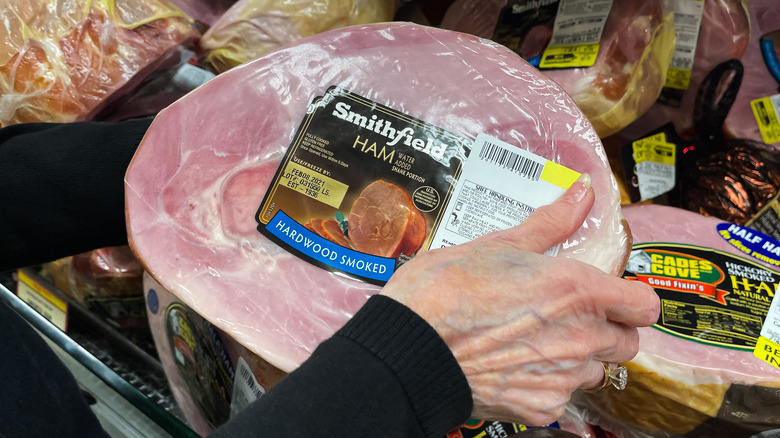The Curing Process Smithfield Hams Must Go Through
As the winter holidays approach, families consider which of the "big three" types of meat will make an appearance on their tables. Will it be turkey, ham, or roast beef? Of course, there are other options like lamb and goose but the aforementioned three are what Americans tend to see advertised the most and what they opt for. Turkeys can be roasted, deep fried, spatchcocked, stuffed, and smoked. Roast beef can come in the form of prime rib, beef tenderloin, brisket, or rump roast. But the humble ham is typically pretty simple: cold or warm, sliced or whole. It's unfussy, uncomplicated, and still festive. It may not seem like it, but ham is one of the most versatile cuts of meat found around the world. From the hind leg of a hog comes Italian prosciutto, French Bayonne, German Black Forest, Spanish Iberico, and many others, per The Spruce Eats.
Americans may include these ham varieties on their holiday charcuterie boards, but when it comes to the main course, a cured whole ham is the star. Depending on where they come from and how they are prepared, hams can be a fairly inexpensive option, especially compared with the steep cost of a prime rib or an organic, free-range turkey. However, if you stumble upon Virginia's own Smithfield ham while shopping for your holiday dinner, you may be surprised at the high price tag. It takes a lot of effort for a ham to become a Smithfield ham.
More than mere pork
Smithfield is a small town in Hampton Roads, Va., that produces thousands of hams every year and all Smithfield hams must be produced here. In this sense, they are as exclusive as French champagne and Parmigiano Reggiano cheese. But location isn't the only thing that sets these hams apart. According to NPR, a Smithfield ham first must be produced from a pig that is raised in Virginia. The animals are specifically fed peaches and Virginia peanuts, among other goodies they can scrounge up. Once the pig is butchered, the hams are cured with salt and potassium nitrate, both to impart flavor and act as a preservative since they are left to sit for up to three weeks. Smithfield then coats the meat in a spice mixture before smoking it over hickory or oak wood. The hams are then aged for about six months before they are ready to be sold.
The Spruce Eats notes that Smithfield hams are red, are on the saltier side, and are prized by those with gourmet palates. Like many other hams, they are available fully cooked and sliced or uncooked. If you purchase an uncooked ham, Smithfield Marketplace says that it will need to be soaked first before cooking, and there may even be some mold on the surface, which is completely normal due to the aging process and can simply be scraped off. It will make a grand centerpiece for your holiday table and the leftover possibilities are endless.

